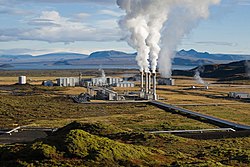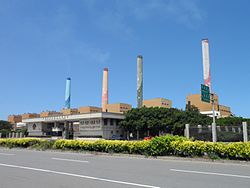Thermal power station

Mohave Generating Station, a 1,580 MW thermal power station near Laughlin, Nevada, US, fuelled by coal.

Geothermal power station in Iceland.
A thermal power station is a power station in which heat energy is converted to electric power. In most of the places in the world theturbine is steam-driven. Water is heated, turns into steam and spins a steam turbine which drives an electrical generator. After it passes through the turbine, the steam is condensedin a condenser and recycled to where it was heated; this is known as a Rankine cycle. The greatest variation in the design of thermal power stations is due to the different heat sources; fossil fuel dominates here, although nuclear heat energy and solar heat energy are also used. Some prefer to use the term energy center because such facilities convert forms of heat energy into electrical energy.[1] Certain thermal power stations also are designed to produce heat energy for industrial purposes, or district heating, or desalination of water, in addition to generating electrical power.
Types of thermal energy
Almost all coal, petroleum, nuclear,geothermal, solar thermal electric, and waste incineration plants, as well as many natural gas power stations are thermal. Natural gas is frequently combusted in gas turbines as well as boilers. The waste heat from a gas turbine, in the form of hot exhaust gas, can be used to raise steam, by passing this gas through aheat recovery steam generator (HRSG) the steam is then used to drive a steam turbine in a combined cycle plant that improves overall efficiency. Power stations burning coal, fuel oil, or natural gas are often called fossil fuel power stations. Some biomass-fueled thermal power stations have appeared also. Non-nuclear thermal power stations, particularly fossil-fueled plants, which do not usecogeneration are sometimes referred to asconventional power stations.
Commercial electric utility power stations are usually constructed on a large scale and designed for continuous operation. Virtually all Electric power stations use three-phaseelectrical generators to produce alternating current (AC) electric power at a frequency of 50 Hz or 60 Hz. Large companies or institutions may have their own power stations to supply heating or electricity to their facilities, especially if steam is created anyway for other purposes. Steam-driven power stations have been used to drive most ships in most of the 20th century until recently. Steam power stations are now only used in large nuclear naval ships. Shipboard power stations usually directly couple the turbine to the ship's propellers through gearboxes. Power stations in such ships also provide steam to smaller turbines driving electric generators to supply electricity.Nuclear marine propulsion is, with few exceptions, used only in naval vessels. There have been many turbo-electric ships in which a steam-driven turbine drives an electric generator which powers an electric motor forpropulsion.
Cogeneration plants, often called combined heat and power (CH&P) facilities, produce both electric power and heat for process heat or space heating, such as steam and hot water.
History
The initially developed reciprocating steam engine has been used to produce mechanical power since the 18th Century, with notable improvements being made by James Watt. When the first commercially developed central electrical power stations were established in 1882 at Pearl Street Station in New York and Holborn Viaduct power stationin London, reciprocating steam engines were used. The development of the steam turbinein 1884 provided larger and more efficient machine designs for central generating stations. By 1892 the turbine was considered a better alternative to reciprocating engines;[2]turbines offered higher speeds, more compact machinery, and stable speed regulation allowing for parallel synchronous operation of generators on a common bus. After about 1905, turbines entirely replaced reciprocating engines in large central power stations.
The largest reciprocating engine-generator sets ever built were completed in 1901 for theManhattan Elevated Railway. Each of seventeen units weighed about 500 tons and was rated 6000 kilowatts; a contemporary turbine set of similar rating would have weighed about 20% as much.[3]
Thermal power generation efficiency

A Rankine cycle with a two-stage steam turbine and a single feed water heater.
The energy efficiency of a conventional thermal power station, considered salable energy produced as a percent of the heating value of the fuel consumed, is typically 33% to 48%.[4][not in citation given] As with all heat engines, their efficiency is limited, and governed by the laws of thermodynamics. Other types of power stations are subject to different efficiency limitations, mosthydropower stations in the United States are about 90 percent efficient in converting the energy of falling water into electricity[5] while the efficiency of a wind turbine is limited byBetz's law, to about 59.3%.
The energy of a thermal power station not utilized in power production must leave the plant in the form of heat to the environment. This waste heat can go through a condenserand be disposed of with cooling water or incooling towers. If the waste heat is instead utilized for district heating, it is calledcogeneration. An important class of thermal power station are associated withdesalination facilities; these are typically found in desert countries with large supplies of natural gas and in these plants, freshwater production and electricity are equally important co-products.
The Carnot efficiency dictates that higher efficiencies can be attained by increasing the temperature of the steam. Sub-critical fossil fuel power stations can achieve 36–40% efficiency. Supercritical designs have efficiencies in the low to mid 40% range, with new "ultra critical" designs using pressures of 4400 psi (30.3 MPa) and multiple stage reheat reaching about 48% efficiency. Above the critical point for water of 705 °F (374 °C) and 3212 psi (22.06 MPa), there is no phase transition from water to steam, but only a gradual decrease in density.
Currently most of the nuclear power stations must operate below the temperatures and pressures that coal-fired plants do, in order to provide more conservative safety margins within the systems that remove heat from the nuclear fuel rods. This, in turn, limits their thermodynamic efficiency to 30–32%. Some advanced reactor designs being studied, such as the very-high-temperature reactor,Advanced Gas-cooled Reactor, andsupercritical water reactor, would operate at temperatures and pressures similar to current coal plants, producing comparable thermodynamic efficiency.
Electricity cost
The direct cost of electric energy produced by a thermal power station is the result of cost of fuel, capital cost for the plant, operator labour, maintenance, and such factors as ash handling and disposal. Indirect, social or environmental costs such as the economic value of environmental impacts, or environmental and health effects of the complete fuel cycle and plant decommissioning, are not usually assigned to generation costs for thermal stations in utility practice, but may form part of an environmental impact assessment.
Typical coal thermal power station
For units over about 200 MW capacity, redundancy of key components is provided by installing duplicates of the forced and induced draft fans, air preheaters, and fly ash collectors. On some units of about 60 MW, two boilers per unit may instead be provided. The list of coal power stations has the 200 largest power stations ranging in size from 2,000MW to 5,500MW.




Comments
Post a Comment